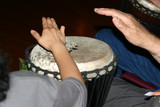Looking for a Better Drum Sound? Check Your Drum Heads!
Because drummers like to be different, we tend to gravitate toward the complexities of life. Such as choosing the right drum or drums for the music we want to play. Everyone knows that drums come in all sorts of different styles, sizes, brands and configurations. There are hand drums like djembes, doumbeks and congas or drum set and component drums like snares, toms and bass drums. While all drums have different drum heads to consider, drum set drummers may have the most intriguing spectrum of options available.
Keep in mind, it is the sound of a drum set that usually makes these decisions more difficult – and that’s before you even get into cymbals and accent percussion. For the non-drummer, there isn’t much to worry about when it comes to the sound of drums, despite how the drum’s shell, rim and drum heads influence those tonal nuances. For the rest of us, we can appreciate the changes in tone between a maple drum shell and a metal drum shell, and that same sound difference is even more noticeable with the drum heads we choose.
The way a drum set sounds is such a personal time and financial investment, no wonder there are so many to choose from. We all want quality drum heads that can deliver our personal brand of rhythmic greatness for as long as possible. Then, we still have to figure out the style of drum head that is best for that same personal brand. So, which is right for you?
- Single-ply drum heads may be the most recognizable on beginner drum sets or jazz drums. These drum heads are more affordable, which is great for beginners and kids. Jazz drummers may prefer the single-ply drum head because of the full range of overtones when playing. Think warm, well-rounded, and sensitive.
- Textured drum heads reduce or alter the overtones of the single-ply version, spicing it up or toning it down while still maintaining a good level of resonance. There are various textures used for notable differences in the tone, whether warm, dark or even a bit like an animal skin drum head.
- Coated drum heads muffle the natural sound of the drum in comparison to a single-ply drum head. Coatings can be fully across the entire surface of the drum head, in a “spot” in the center or around the rim of the drum. The spot or “power dot” of the drum is a great focal point for hitting hard, especially for rock drummers when volume and durability are more important than full resonance.
- Double-ply drum heads muffle the overtones of the drum and are also especially great for marching band, rock and R&B drummers and anyone who can’t help but beat up their drum. Double-ply drum heads are best for drummers who seek power, attack and less overtones.
As with any major decision in a drummer’s life, the choice in drum heads often comes down to a personal preference in the sound of the beat. Just like a drummer may go through several different configurations of component drums on a drum set, the drum head selection may be just as “up in the air” until that perfect sound is developed. The silver lining in discovering which drum head is best is that it only encourages us all to keep on drumming… and really, that’s what it’s all about.
Recent Posts
-
X8 Drums Play-Along Backing Tracks
The new X8 Play-Along Series is being produced for our musician friends wanting a fresh way to work …9th Feb 2025 -
What is the Best Size Djembe for Beginners?
If you're new to the world of percussion and interested in learning the djembe, you're in for a t …16th Jul 2024 -
The Benefits of Becoming a Drumming Teacher: Transforming Passion into Profession
Why become a drumming teacher? Becoming a drumming teacher is an excellent way to share your pas …22nd May 2024



